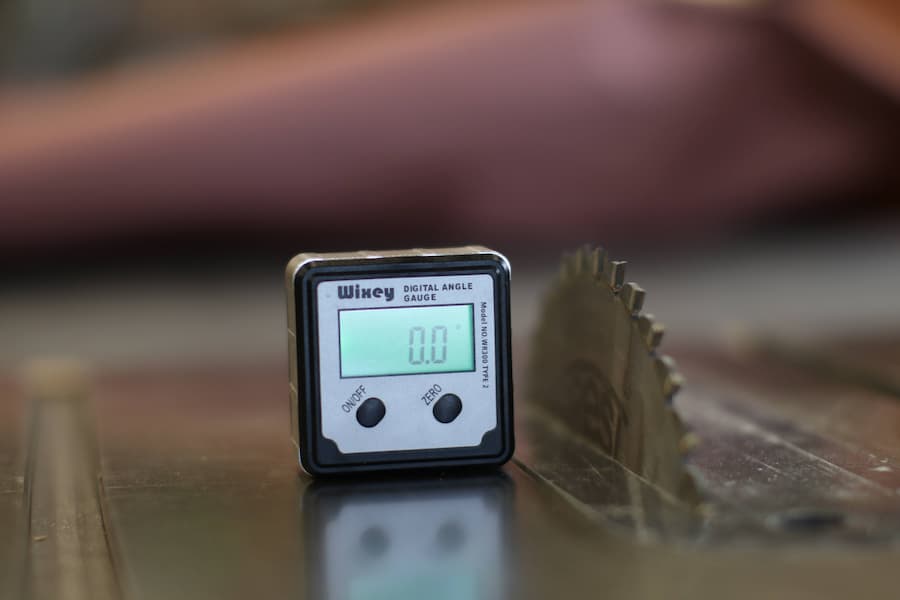As an Amazon Associate we earn from qualifying purchases.
Digital angle gauges are used by woodworkers to get precise results. Fine woodworking requires precise angles, and your digital angle finder must be completely accurate for your wood piece to turn out square and true. But, how do you know if your digital angle gauge is accurate?
Contents
Are Digital Angle Gauges Accurate?
Digital angle gauges, also called digital protractors or digital angle finders, are highly accurate when properly calibrated and used according to the instructions. The main cause of inaccuracy in digital measuring tools like angle gauges is a low or weak battery.

The product specifications should list a threshold for accuracy. When fully powered and in good working condition, most digital angle gauges are accurate to +/- 0.1 inch. The best digital angle gauges are even more accurate – check the specifications sheet for exact data about specific models.
You can ensure the continued accuracy of your angle finder by changing the batteries as soon as the low battery indicator appears, and keeping the tool free from moisture and debris.
Digital angle gauges usually have a gasket around the interior casing to prevent dust or moisture from entering the inner workings of the tool. Keep your digital angle gauge in a pocket or tuck it in a drawer when it’s not in use. This will help protect it from debris. Never let your digital angle gauge get wet.
You can check the accuracy of a hinged arm digital angle gauge using a carpenter’s square.
Check Accuracy of Hinged-Arm Digital Angle Gauge With a Carpenter’s Square
A carpenter’s square (which is shaped like a triangle) offers a standard against which you can check the accuracy of your hinged-arm digital angle gauge.
- Place the carpenter’s square on a flat surface.
- Position the arms of the digital angle gauge flush with one of the 45-degree angles on your carpenter’s square.
- Press the button to zero out the display.
- Remove the digital angle gauge from the carpenter’s square and close the arms until the display shows exactly 45 degrees.
- Press the button and zero out the display again.
- Open the arms again and position them around the 90 degree angle on your carpenter’s square. If the digital readout displays 90 degrees, your digital angle gauge is accurate and ready to use.

What Can You Do With a Digital Angle Finder?
Digital angle finders can help you measure an existing angle or provide a guide to create a new angle. They are commonly used in trim work and to adjust the angle of saw blades. Any time you need to make a bevel, miter, or compound bevel cut, a digital angle finder will come in handy.
Trim Work
Digital angle finders take the guesswork and hassle out of measuring and cutting trim, whether in the form of baseboard or crown molding.
Trim provides protection to your walls and beautifies your home. Installing baseboard and trim is easy – if you’ve properly measured and cut it first. That’s where a digital angle finder comes in handy.
Guessing or approximating the angles of the walls leads to mistakes, frustration, and wasted material. An analog protractor is an option, but they lack the precision and ease of use that make digital angle finders so helpful. Some models will even convert the measurement of the existing angle into a miter or bevel angle, and save your measurements for ongoing use.
Miter and Bevel Cuts
When you make an angled cut into a piece of wood, you produce a miter or bevel. Miters are made on the face of the board, while bevels are cut across the board’s width.
Angled Joints
If you want to join two boards to form a 120 degree angle, each of the boards will need to be cut at a 60 degree angle.
Set a hinged arm digital angle gauge to 60 degrees and use the angle finder arm as a straightedge to mark your cut. From there, it’s as simple as setting your miter or table saw to the appropriate angle and matching the blade up with your cut mark.

Measure Compound Bevel Angles
When you want to make a cut across the width and depth of a board, you need to make a compound bevel cut. Only certain kinds of miter saws are capable of making this cut in one pass. If you aren’t equipped with this kind of saw, you will need to make multiple cuts, requiring multiple calculations, to produce a compound bevel.
Many hinged-arm digital angle gauges are capable of making those calculations and conversions for you, saving you time and energy as well as ensuring your accuracy.
Conclusion
Digital angle gauges are accurate to within one-tenth of an inch. Change the batteries promptly and keep the gauge clean and dry for optimal performance. If you’re concerned about the accuracy of your hinged-arm digital angle gauge, you can check it with a carpenter’s square.
